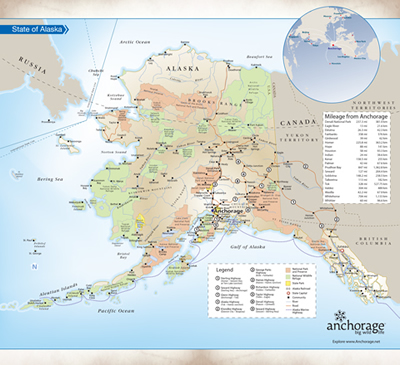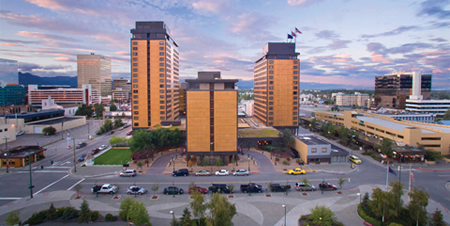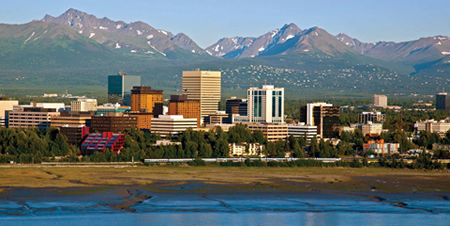

What ties could Alaska have to the taxi industry? Well, you might be surprised. After all, Alaska is home to the U.S. city with the most cabs per capita.
Bethel, Alaska, has a population of 6,000. There are 70 taxis in Bethel, approximately one for every 85 people. That’s the highest ratio of U.S. cities. For perspective, New York City has roughly one cab for every 149 people.
Bethel, located in the southwest part of Alaska on the Tundra roughly 400 miles away from Anchorage, has no roads leading into, and therefore out of the town. Few residents have cabs because of the exorbitant costs associated with getting a vehicle to Bethel. Even more, the cost of gas is notably expensive. That’s why the vice-mayor of Bethel told the Atlantic in 2015 that taxis really served as public transit in the town.
Interestingly, Bethel is known as the commercial hub for much of the area. It’s the most convenient place to see a doctor or run errands for miles around—even hundreds of miles around.
But one of Bethel’s true claims to fame is its number of taxis.
Maybe it’s fitting, then, that Alaska, known as “the last frontier,” will host the Mid-Year International Leadership Conference for the Taxicab, Limousine & Paratransit Association from July 12-15 in the Captain Cook Hotel in Anchorage. Though you won’t be able to trek to Bethel, there’s plenty to see. After all, as Alaska’s State Travel Bureau puts it, Alaska is the land of superlatives.

It’s home to the largest national park, the highest peak in North America, the longest coastline in the U.S., it’s the biggest state, and in the summer, it has the longest day. So yes, there’s plenty to see in Alaska!
Other highlights include endless chains of mountains, the “Big Five” North American land mammals, including grizzly bears, moose, caribou, wolf, and Dall sheep, and glaciers throughout the state. After all, Alaska has been largely untouched by humans. Tourists can take helicopter tours to see the glaciers or cruises on the sea to watch for whales.
Anchorage itself has plenty of options for even a seasoned traveler. It’s Alaska’s largest city and widely known for its culture, including the Native Heritage Center which documents the history of the area’s indigenous groups.
So, save the date for the 2017 Mid-Year International Leadership Conference (July 12-15) and make your plans now as TLPA readies to take on Alaska, “land of superlatives,” “the last frontier,” and a state like no other in America!

Population: 301,000. Anchorage is Alaska’s largest city with 41 percent of the state’s population.
Time Zone: Anchorage, and virtually all of Alaska, is in Alaska Standard Time, one hour behind Pacific Standard Time and four hours behind Eastern Standard Time.
Size: Anchorage encompasses 1,961 square miles from Portage Glacier to Eklutna - about the size of the state of Delaware.
Anchorage was established in 1914 as a railroad construction port for the Alaska Railroad which was built between 1915 and 1923. Ship Creek Landing, where the railroad headquarters was located, quickly became a tent city. Anchorage was incorporated on November 23, 1920.
The city’s economy in the 1920s centered around the railroad. Between the 1930s and the 1950s, the city experienced massive growth as air transportation and the military became increasingly important. Merrill Field opened in 1930, and Anchorage International Airport opened in 1951. Elmendorf Air Force Base and Fort Richardson were constructed in the 1940s.
On March 27, 1964, Anchorage was hit by the magnitude 9.2 Good Friday Earthquake which killed 115 Alaskans and caused $1.8 billion in damage (2007 U.S. dollars). The earth shaking event lasted nearly five minutes. Most structures that failed remained intact the first few minutes, then failed with repeated flexing. Rebuilding dominated the city in the mid 1960s.
In 1968, oil was discovered in Prudhoe Bay, and the resulting oil boom spurred further growth in Anchorage. In 1975, Anchorage merged with Eagle River, Girdwood, Glen Alps, and several other communities. The merger expanded the city known officially as the Municipality of Anchorage. The city continued to grow in the 1980s, and capital projects and an aggressive beautification campaign took place.
Anchorage is located in South Central Alaska. It lies slightly farther north than Oslo, Stockholm, Helsinki and St. Petersburg. It is northeast of the Alaska Peninsula, Kodiak Island, and Cook Inlet, due north of the Kenai Peninsula, northwest of Prince William Sound and Alaska Panhandle, and nearly due south of Mount McKinley/Denali.
The city is on a strip of coastal lowland and extends up the lower alpine slopes of the Chugach Mountains. To the south is Turnagain Arm, a fjord that has some of the world’s highest tides. Knik Arm, another tidal inlet, lies to the west and north. The Chugach Mountains on the east form a boundary to development, but not to the city limits which encompass part of the wild alpine territory of Chugach State Park.
The city’s seacoast consists mostly of treacherous mudflats. Newcomers and tourists are warned not to walk in this area because of extreme tidal changes and sticky mud.
To the north is Matanuska-Susitna Borough (Mat-Su Valley) which is included with the MOA as a metropolitan area by the US Census Bureau. Although the Mat-Su is a “bedroom community” for Anchorage, the towns, exurbs, farms, and homesteads there have varied local cultures quite distinct from that of Anchorage proper. Between metropolitan Anchorage and the valley, the communities of Eagle River and Chugiak, though part of the MOA, also have distinct identities.
According to the United States Census Bureau, the municipality has a total area of 1,961.1 square miles (5,079.2 km²), of which 1,697.2 square miles (4,395.8 km²) is land and 263.9 square miles (683.4 km²) is water. The total area is 13.46% water. The area of Anchorage is thus larger than that of the state of Rhode Island.
Anchorage is a major port receiving over 95% of all freight entering Alaska, as well as a hub of the Alaska Railroad. Major industries include government and military, petroleum, and tourism. There are two U.S. military bases bordering Anchorage on the north: Elmendorf Air Force Base and Fort Richardson.
Nearly all Alaska Interior bound tourists pass through Anchorage at some stage of their journeys in Alaska. Not surprisingly, summer is tourist season, and downtown Anchorage, as well as the highways leading north and south of town, are typically teeming with tourists.
Anchorage has a subarctic climate (the Köppen climate classification is Dfc) due to its short, cool summers. Average daytime summer temperatures range from approximately 55 to 78 degrees Fahrenheit (13 to 26 degrees Celsius). Average daytime winter temperatures are about 5 to 30 degrees (-15 to -1 degrees Celsius). Anchorage has a frost free growing season that averages slightly over 100 days.
Average January low and high temperatures at Ted Stevens Anchorage International Airport (PANC) are 9 °F/22 °F (-13 °C/-5 °C) with an average winter snowfall of 70.60 inches (179.3 cm). The 1954-1955 winter had 132.8 inches (337.3 cm), which made it the snowiest winter on record.
The coldest temperature ever recorded at the original weather station located at Merrill Field on the East end of 5th Avenue was -38 °F (-38.8 °C) on February 3, 1947.
Summers are typically mild although cool compared to the contiguous US and even interior Alaska. It can rain frequently. Average July low and high temperatures are 52 °F/66 °F (11 °C/19 °C) and the hottest reading ever recorded was 92 °F (33.3 °C) on June 25, 1953. The average annual precipitation at the airport is 16.07 inches (408 mm).
Owing to its proximity to active volcanoes, ash hazards are a significant, though infrequent occurrence. The most recent notable incident was an August 1992 eruption of Mount Spurr which is located 78 miles west of the city. The eruption deposited about 3 mm of volcanic ash on the city. The clean up of ash resulted in excessive demands for water and caused major problems for the Anchorage Water and Wastewater Utility.
Because of Anchorage’s latitude, summer days are very long and winter daylight hours are very short. Anchorage is often cloudy during the winter which decreases the amount of sunlight experienced by residents.